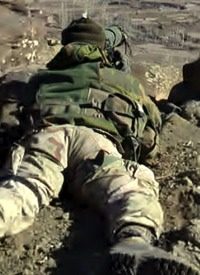
Voice of America News reported on September 27 that Afghan and NATO forces engaged in Operation Dragon Strike are conducting a major push to drive Taliban militants out of their stronghold around the southern city of Kandahar.
NATO assumed control of the International Security Assistance Force (ISAF) in 2003. The ISAF was originally established by the UN Security Council in 2001, after the U.S.-led invasion that drove the Taliban regime from power in Afghanistan.
VOA cited NATO spokesman Josef Blotz, identified as a German brigadier general, who said that Afghan and NATO forces expect tough battles in the coming days. Blotz said that the goal of Operation Dragon Strike is to destroy Taliban positions around Kandahar and force the militants either to evacuate the area or to engage operation troops with the expectation that many Taliban would be killed.
VOA also cited Afghan officials who said, in addition to the military operation, their government also is focused on implementing development projects in Kandahar and that driving out the Taliban-controlled militants in the southern region is a key part of the U.S.-led strategy to help Kabul extend its authority over the country.
One statement reported by VOA, which is is the official external radio and television broadcasting service of the U.S. government, was directly contradicted by a New York Times report on the same subject. VOA reported: “There are no reports of casualties among Afghan or NATO forces since the operation began in recent days.”
However, the Times reported in its September 27 edition: “Sixteen Americans have died in the push so far, including two killed by a roadside bomb on Sunday.”
The Times also quoted General Blotz, who predicted of the offensive: “We expect hard fighting.”
“This is the most significant military operation ongoing in Afghanistan,” added Blotz, who called the mission near Kandahar as “top operational priority now.”
As things escalate in the Kandahar region, Reuters news quoted from a statement made by British Lieutenant-General Nick Parker, second-in-command of the International Security Assistance Force behind U.S. General David Petraeus. Parker is wary of adhering too firmly to the announced 2011 deadline announced by President Obama for beginning to draw down the number of NATO troops in Afghanistan. “What we must not do is pull back and go blind, because it then becomes extremely difficult to re-intervene, if you need to,” Parker told reporters in London through a satellite link from Afghanistan.
“What we’ve got to do is to thin back and then reinvest some of that dividend into other areas so there is a sense of continuing commitment. It’s not a sort of rush for the exit,” he added.
BBC News also quoted Parker as stating that the July 2011 deadline was an “interesting milestone,” and also cited Parker’s belief that the significance of the date was being “overstated.”
Parker stated that his advice would be for “as few as possible” troops to be pulled out next year.
He continued: “It is entirely reasonable for there to be some drawdown of some sort, although I suggest that all the indicators I’ve heard are this is not as significant as some people choose to make it out to be.
“We will by July next year have many more Afghans in the front line and we will have many more Isaf (Nato-led International Security Assistance Force) troops providing enabling and supporting functions.”
Parker added: “My military advice is, we should be cautious.
“We should not in any way let the Afghans feel that we are not supporting them and allowing them to do what will remain a very challenging security task. This is a debate which we need to be very measured about.”
Those wondering about how we became so thoroughly enmeshed in Afghanistan, exactly what our mission is, and when it will be completed, may want to review some basic background information.
A mission statement posted on NATO’s website states:
NATO’s main role in Afghanistan is to assist the Government of the Islamic Republic of Afghanistan (GIRoA) in exercising and extending its authority and influence across the country, paving the way for reconstruction and effective governance. NATO does this predominantly through its United Nations-mandated International Security Assistance Force (ISAF).
Since NATO took command of ISAF in 2003, the Alliance has gradually expanded the reach of its mission, originally limited to Kabul, to cover all of Afghanistan’s territory. Accordingly, the number of ISAF troops has grown from the initial 5000 to around 120,000 troops from 47 countries, including all 28 NATO member nations….
In accordance with relevant Security Council Resolutions, ISAF assists the Afghan government in the establishment of a secure and stable environment. [Emphasis added.]
Statements on NATO’s website also note that NATO is “a political and military alliance” that “takes an active role in crisis management operations, most of them under a UN Security Council mandate.”
NATO was originally sold to the American people as a trans-Atlantic alliance to defend Western Europe, which had been devastated by World War II, from potential aggression by the Soviet bloc. The Soviet bloc has broken up, but NATO remains, constantly reinventing itself as the enforcement arm of the UN Security Council, which “mandates” such operations.
Photo: AP Images



